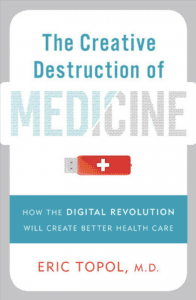
What if your cell phone could detect cancer cells circulating in your blood or warn you of an imminent heart attack? Mobile wireless digital devices, including smartphones and tablets with seemingly limitless functionality, have brought about radical changes in our lives, providing hyper-connectivity to social networks and cloud computing. However, the digital world has hardly pierced the medical cocoon.


Until now. In his recent speech at e-Health 2013 conference, Eric Topol, Author of The Creative Destruction of Medicine, highlighted just how he foresees the next medical revolution with digital tools that change the way we engage with physicians. Topol suggests digitizing healthcare with the four S’s: Social Media, Sensors, Scans, and Sequencing. Increasing use of sensors and scans used in or attached to a smartphone allows patients to manage disease and revise our interaction with physicians so it is more of an advisor relationship (for example, a heart attack ring tone triggered by Nano sensor connected to a smart phone allows for prevention and proactive cardiac health management).
However, Topol foresees a shift from a provider-centric to a truly patient-centric system where patient care will change to “nothing about me without me.” Meaning full patient disclosure and decision-making driving health care options vs. the current 70% of physicians who think patients shouldn’t have access to their clinical notes.
One key component that all patients are wanting is greater insight into their treatment path and how they can speed up that process. Having patients wait in the Canadian healthcare system costs us $6.45 billion annually. Annual healthcare spending in Canada is about $172 billion, or 10 percent of our national GDP. Healthcare eats up to 40% of provincial and territorial budgets. Up to 30% of this spend is unnecessary waste, and an estimated one eighth of this waste is attributed to waiting.
Patient outcomes are indeed affected by the baffling wait times patients endure to get satisfactory treatment. One of the key reasons for this is that a critical case of operational inefficiency has infected our health systems.
No one wants to make patients wait, the problem is, they may not know who and where the waiting patients are.
There is tremendous value in looking at the process by which patient flow is influenced and by how they are transitioned from one health care level to another.
At a time when the digital revolution can produce tools to deliver real-time information for a patients’ symptoms, Strata PathWays provides an effective tool to deliver real-time symptoms of a health system’s operational inefficiencies. Through the automation of best practices within the referral process and leveraging proprietary matching algorithms to identify the Right Patient to the Right Care Destination at the Right Time, PathWays™ reduces and ELIMINATES unnecessary WAIT and WASTE.
The modern eReferral utilizes standardized processes that are client-driven and objective. Patient prioritization for urgent community or compassionate placement is key. Health system prioritization pinpoints organizational/regional stressors for maximum discharge efficiency through custom sorting algorithms and auto-client transfer to choice of alternative care. Matching patient clinical needs (based on client preference, geographic, timing, and eligibility profiles) to single/multiple programs/beds, or directly to a central access point, while showing live wait times during the process is a hallmark feature of a robust intelligent eReferral solution.
Intelligent eReferral solutions that enhance the healthcare process and demonstrate daily gains in client service levels lead to better system productivity and outcomes. When these systems additionally improve communication, patient insight and patient navigation through the healthcare system, all at lower costs, the result is a win-win situation for all parties. This is why Patients Shouldn’t Wait.
To learn more download: The Healthcare Executive’s Guide to Accelerating the Value of Health Information Exchanges with Resource Matching and Intelligent eReferral.